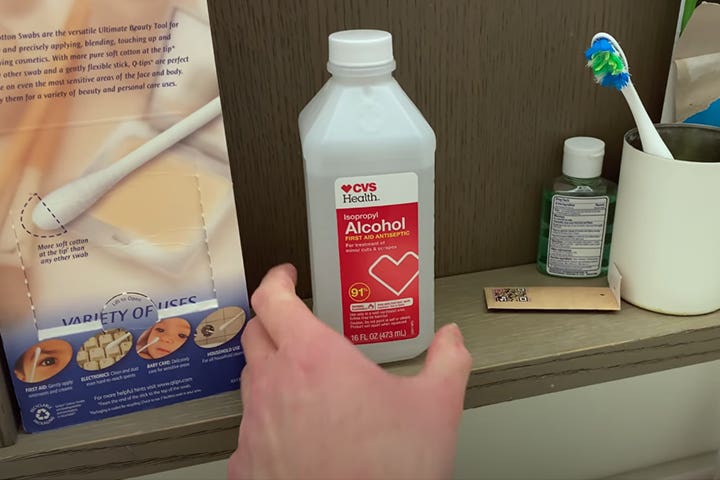Mixing bleach and rubbing alcohol can create chloroform, a highly toxic substance that can cause damage to the eyes, lungs, and liver. It is important to immediately dispose of the mixture and avoid adding any other chemicals as it could result in the creation of other dangerous substances.
The Dangers Of Mixing Bleach And Alcohol
Mixing bleach and rubbing alcohol can be extremely dangerous as it can create chloroform, which can lead to unconsciousness, liver damage, and respiratory or cardiac failure. It is important to immediately dispose of the mixture and avoid adding any other chemicals to it.
Mixing bleach and alcohol can have severe consequences for your health. Here are some dangers to be aware of:
Can Isopropyl Alcohol And Bleach Make Someone Unconscious?
- Mixing isopropyl alcohol and bleach can lead to the formation of chloroform.
- Chloroform can cause someone to become unconscious and can also lead to liver damage.
- Inhaling chloroform can result in potential respiratory or cardiac failure.
Chloroform Formation And Its Effects On The Body:
- When bleach and alcohol are combined, they can react to produce chloroform.
- Chloroform is a colorless, sweet-smelling liquid that is highly volatile and can easily be inhaled.
- Inhaling chloroform can cause dizziness, nausea, headaches, and can also lead to liver and kidney damage.
Potential Respiratory And Cardiac Failure:
- Mixing bleach and alcohol can lead to the production of toxic gases, such as chloramine and chlorine gas.
- Inhaling these gases can result in shortness of breath, chest pain, and can even cause respiratory and cardiac failure.
- These gases can also irritate the eyes, throat, and respiratory system, leading to coughing and difficulty breathing.
Remember, it is crucial to never mix bleach and alcohol or any other cleaning products together. The resulting chemical reactions can create dangerous substances that can pose serious risks to your health.

Credit: sciencenotes.org
What Cannot Be Mixed With Bleach?
Mixing bleach and rubbing alcohol can be extremely dangerous as it produces chloroform, a highly toxic substance. This combination can cause liver damage, respiratory or cardiac failure, and unconsciousness. It is important to immediately dispose of the mixture and avoid adding other chemicals to it.
Bleach is a powerful cleaning agent, but it is important to avoid mixing it with certain substances. The following are some things that should never be mixed with bleach:
- Mixing bleach with ammonia:
- Ammonia and bleach combined can create toxic fumes, such as chloramine and hydrazine. These fumes can cause serious respiratory problems, chest pain, and even potential organ damage.
- Mixing bleach with acids:
- Acids like vinegar or lemon juice mixed with bleach can produce chlorine gas. Breathing in chlorine gas can lead to coughing, breathing difficulties, and irritation of the respiratory system.
- Mixing bleach with other cleaners:
- Combining bleach with other cleaners, especially those containing hydrogen peroxide or alcohol, can result in the production of harmful substances such as chloroform. Inhalation of chloroform can cause unconsciousness, liver damage, and even respiratory or cardiac failure.
Remember, it is crucial to always read the product labels before using cleaning products. Mixing bleach with these substances can have serious consequences and pose risks to your health. If accidentally mixed, it is important to dispose of the mixture properly and avoid adding any other chemicals to the mix to prevent the creation of other hazardous substances.
Stay Safe And Use Cleaning Products Responsibly!
Hazards Of Mixing Bleach With Vinegar And Rubbing Alcohol
Mixing bleach with vinegar and rubbing alcohol can be extremely dangerous. It can produce toxic gases such as chlorine gas and chloroform, which can cause respiratory problems, eye irritation, and even liver damage. It is important to avoid combining these substances to ensure personal safety.
Mixing certain household chemicals can have dangerous consequences. In particular, combining bleach with vinegar or rubbing alcohol can create hazardous compounds that pose serious risks to your health. It is crucial to understand these dangers in order to ensure the safety of yourself and those around you.
Chlorine Gas Production From Bleach And Vinegar Mixture
When bleach and vinegar are mixed together, they produce chlorine gas. This gas is highly toxic and can cause a range of health issues, including:
- Coughing and breathing difficulties
- Burning and watery eyes
- Irritation of the skin, throat, and lungs
Symptoms Of Exposure To Chlorine Gas
Exposure to chlorine gas can lead to several symptoms, which can vary depending on the level of exposure. Common symptoms include:
- Coughing and wheezing
- Shortness of breath and chest tightness
- Nausea and vomiting
- Headache and dizziness
- Irritation of the eyes, nose, and throat
Toxic Effects Of Chloramine Produced By Bleach And Ammonia
Mixing bleach with ammonia can create a toxic gas called chloramine. This gas is harmful and can cause severe respiratory distress. It is important to note that even small amounts of this gas can be dangerous.
Exposure to chloramine can result in:
- Chest pain and tightness
- Difficulty breathing and shortness of breath
- Coughing and wheezing
- Nausea and vomiting
Highly Toxic Nature Of Chloroform From Bleach And Rubbing Alcohol Mixture
A mixture of bleach and rubbing alcohol can produce chloroform, which is highly toxic and poses significant health risks. Inhaling chloroform can lead to:
- Loss of consciousness and dizziness
- Liver damage
- Respiratory and cardiac failure
Remember, it is essential to avoid mixing bleach with vinegar or rubbing alcohol, as it can lead to the production of harmful gases and substances. Be cautious when handling these chemicals and always read product labels to ensure safe usage.
Your health and the well-being of others are of utmost importance, so take the necessary precautions to prevent any accidents or exposure to toxic substances.
Frequently Asked Questions Of What Happens If You Mix Bleach And Rubbing Alcohol
What To Do If I Accidentally Mixed Bleach And Alcohol?
If you accidentally mix bleach and alcohol, it is important to immediately dispose of the mixture. Do not add any other chemicals, as this can create dangerous substances.
Can Isopropyl Alcohol And Bleach Make Someone Unconscious?
Mixing isopropyl alcohol (rubbing alcohol) and bleach can create chloroform, which can potentially make someone unconscious. It can also cause liver damage, respiratory or cardiac failure. It’s important to avoid accidentally mixing these substances and dispose of any created mixture immediately.
What Cannot Be Mixed With Bleach?
Bleach should not be mixed with ammonia, acids, or other cleaners. Mixing bleach with these substances can cause serious injuries. Always read the product label before using a cleaning product.
What Happens If You Mix Bleach Vinegar And Rubbing Alcohol?
Mixing bleach, vinegar, and rubbing alcohol can create dangerous substances. It can produce chlorine gas, causing breathing problems and eye irritation. It can also create chloramine, leading to shortness of breath and chest pain. Bleach and rubbing alcohol combined can produce chloroform, which is highly toxic.
It is important to avoid mixing these cleaning products.
Q: Can Mixing Bleach And Rubbing Alcohol Be Dangerous?
A: Yes, mixing bleach and rubbing alcohol can create chloroform, which is highly toxic and can cause harm to your eyes, lungs, and liver.
Conclusion
Mixing bleach and rubbing alcohol can have extremely dangerous consequences. The combination creates chloroform, a highly toxic substance that can cause significant damage to various parts of the body, including the eyes, lungs, and liver. Inhaling chloroform can lead to respiratory and cardiac failure and even unconsciousness.
It is crucial to handle these substances with caution and avoid any accidental mixing. If you accidentally create chloroform by mixing bleach and rubbing alcohol, it is vital to dispose of it immediately. Under no circumstances should you add any other chemicals to the mix, as this can produce equally hazardous compounds.
It is important to read and follow the safety instructions on cleaning product labels, as bleach should never be mixed with ammonia, acids, or other cleaners. Remember, the health and safety risks associated with mixing bleach and rubbing alcohol are severe.
It is essential to prioritize proper chemical management and always exercise caution when handling these substances.

